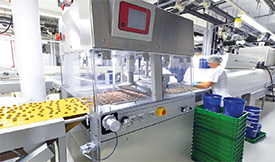
Image Credit: © industrieblick – Fotolia.com
Developing industry requirements, such as Food Safety Modernization Act rules, increase emphasis on contamination prevention as opposed to reaction after the fact. To address these ever increasing requirements, food and beverage companies continuously review all components of their Hazard Analysis and Critical Control Points (HACCP) systems to ensure their process facilities remain in compliance. Lubrication programs, and the various tasks and methods used for proper implementation, are one such component.
In general, machinery lubrication practices are considered prerequisite programs within an HACCP system. The World Health Organization defines prerequisite programs as “Practices and conditions needed prior to and during implementation of HACCP and which are essential for food safety.” According to the USDA, prerequisite programs provide support for hazards not reasonably likely to occur and justification for not adding a potential hazard to the HACCP plan, which is designed to address issues that are likely to occur.
Prerequisite programs within HACCP, such as machinery lubrication, are typically facility-wide programs, as opposed to process- or product-specific. They deal with “good housekeeping” concerns and help reduce the likelihood of certain hazards by managing specific processes. While prerequisite programs fall outside of the detailed HACCP plan, they are still part of the overall HACCP system. Besides machinery lubrication, other examples of prerequisite programs include sanitation, maintenance, and pest control.
For all prerequisite programs, the USDA requires procedures and controls documentation, as well as records and results demonstrating program effectiveness. Noncompliance exists if unsanitary conditions are created such as a food safety hazard. Repeat failures within a prerequisite program may indicate a need to add or update the process in question into the HACCP plan. Mitigating those failures can begin by identifying hazards, developing a survey, training employees, and implementing proper storage.
The objective for the lubrication program is to implement it as a successful prerequisite program. The following are a few suggestions to help accomplish this.
Identify Contamination Risks
The first consideration is where potential contamination related to lubrication may occur. It is important to know if lubricants will come in contact with food as a normal part of the process, as is the case for release agents; or under conditions that are normally not part of the process, such as a developed machine leak.
The reason to note this distinction is that lubricants for food processing facilities are identifiable for their intended use through industry classification systems. For example, NSF 3H (meeting FDA 21 CFR 172.878) is intended for direct contact uses such as release agents, pan oils, and divider oils; and NSF H-1 (meeting FDA 21 CFR 178.3570) is intended for incidental contact uses such as conveyors, hydraulic systems, and gear drives. Identifying and classifying possible food contamination points is crucial.
Repeat failures within a prerequisite program may indicate a need to add or update the process in question into the HACCP plan.
Perform a Lubrication Survey
A detailed lubrication survey is essential in constructing the required prerequisite program documentation. The survey, along with procedure documentation and work records should identify important details including where food grade lubricants are needed, required use classification, responsibility assignments for applying the lubricants correctly, correct lubrication intervals, and best practices for storage and handling. The survey should inventory all lubricated equipment, lubricant products, applications, and identify critical machines and operations. If replacing lubricants, do not simply cross-reference without confirming applications.
Mixing will compromise lubricant food classification grade credentials and can also weaken equipment protection.
Train Employees
For successful food grade lubricant use, those responsible for machinery lubrication should receive proper training. Training should include knowledge of product classification differences, application methods, handling and storage procedures, and correct amounts and intervals. This will mitigate potential problem areas that include, but are not limited to, the following instances.
- Misapplication of lubricant classifications. For example, using a product that is classified only as NSF H-1 (incidental contact) where an NSF 3H (direct contact) lubricant is required.
- Over-lubrication can cause seal rupture due to excessive grease or overflow and/or foaming due to excessive oil level increases the likelihood of food contact.
- Under-lubrication can cause foaming and/or compromise equipment life. Subsequently, more frequent machine teardown increases the possibility of contamination.
- Improper handling and/or fill practices such as improper pump handling techniques and/or use of dirty containers can lead to lubricant contamination.
- Improper storage practices can lead to contamination as water, dirt, and other lubricants can make their way into food-grade lubricants.
Implement Proper Storage
Lubricants should be stored under cover, preferably indoors. To limit moisture contamination, situate products so water does not pool on container tops and avoid areas with wide temperature fluctuations. As you may have heard before, temperature fluctuation can cause containers to “breathe” and suck in moisture from the environment, even if they are sealed.
ACCESS THE FULL VERSION OF THIS ARTICLE
To view this article and gain unlimited access to premium content on the FQ&S website, register for your FREE account. Build your profile and create a personalized experience today! Sign up is easy!
GET STARTED
Already have an account? LOGIN
